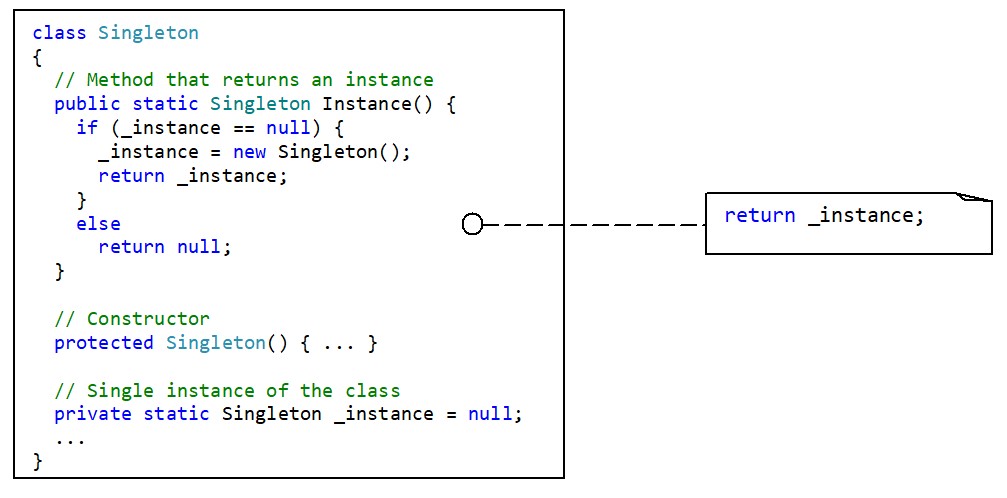Table Of Content

Pentalog is a digital services platform dedicated to helping companies access world-class software engineering and product talent. With a global workforce spanning 16 locations, our staffing solutions and digital services power client success. By joining Globant, Pentalog strengthens its offering with new innovation studios and an additional 51 Delivery Centers to assist companies in tackling tomorrow's digital challenges.
Behvioural Design Patterns
JVM executes a static initializer when the class is loaded and hence this is guaranteed to be thread-safe. Use this method only when your singleton class is light and is used throughout the execution of your program. Here we have declared getInstance() static so that we can call it without instantiating the class. The first time getInstance() is called it creates a new singleton object and after that, it just returns the same object. A Singleton (and this isn't tied to C#, it's an OO design pattern) is when you want to allow only ONE instance of a class to be created throughout your application.
Software Design Pattern in Different Programming Languages
Singleton vs. static classes in C# - InfoWorld
Singleton vs. static classes in C#.
Posted: Mon, 04 Jan 2021 08:00:00 GMT [source]
It belongs to the creational pattern category, dealing with object creation and manipulation. As part of this article, we will discuss the following pointers. Unlike global variables, the Singleton pattern guarantees that there’s just one instance of a class. Nothing, except for the Singleton class itself, can replace the cached instance. The following are the common characteristics of a singleton pattern. The difference is my implementation allows the shared pointers to clean up allocated memory, as opposed to holding onto the memory until the application is exited and the static pointers are cleaned up.
Creational Software Design Patterns in C++
The splitting into NotCopyable and NotMovable clases allows you to define your singleton more specific (sometimes you want to move your single instance). Static is the keyword used in C++ to declare a class method, and the return type is Logger &, a reference to the instance. We will first focus on the elements essential to any class, constructors and destructors, then deal with the addition of the instance and the get_instance method, and finally add the functionalities of the Logger. There exist abounding design patterns, and most of the time, we think first and foremost of the GoF design patterns. My contribution on this blog is particularly minimal, and I’m sure that some books I don’t have yet offer even better implementation methods than mine.Furthermore, some C++ blogs are way more interesting than mine.
This means we have successfully achieved the singleton design pattern with this example. So, the first thing that comes to mind is to restrict the multiple instance creation. We can achieve it by making all constructors private and changing the class to a sealed class so that it is not inherited anymore. The same class behaves incorrectly in a multithreaded environment. Multiple threads can call the creation method simultaneously and get several instances of Singleton class. To overcome this situation, we have to write a double-check locking program as below.
This question was particularly inspiring to me.I implemented a distributed simulation framework in C++11, in which I made extensive use of design patterns. Also, if you want to use Singleton design pattern in your program, make sure not to overuse this pattern. The reason is, it really hard for unit testing due to no other instance variables and any references available. So, do not use this design pattern everywhere it can, instead use whenever it necessary.
Use Case of Pattern Singleton Method
The private constructor prevents the creation of an instance using the new keyword. The above VoteMachine class is a singleton class where its constructor is private and the Instance property returns the same instance every time. Once the global queue is set (via queue_ref()), it can be referenced with the queue variable in any file in which the header file is included (examples are provided below).
JavaScript Design Patterns: The Singleton — SitePoint - SitePoint
JavaScript Design Patterns: The Singleton — SitePoint.
Posted: Fri, 20 Apr 2018 07:00:00 GMT [source]
Now when we run the application, the lock code would not be executed every time but only for the first time when it is accessed because at the second time it will not find the singleInstance field as null. Now, let's try to invoke these methods parallelly using Parallel.Invoke method as shown below. This method can invoke multiple methods parallelly and so we would get into a situation where both methods claim Singleton instance at a same time. By exploring the Singleton Design Pattern in C# .NET, you’ve equipped yourself with a powerful tool for maintaining instance uniqueness and controlling access within your applications. Implementing the Singleton pattern thoughtfully can elevate your software design and contribute to building robust and reliable applications. Here, we can see the counter value has not been incremented, and we have got input from both employees and students as well.

We assume that two clients or two classes (Manager class and Employee class) are creating the objects of Singleton class to log their request message. The Singleton Design Pattern plays a crucial role in maintaining a consistent and controlled application state by ensuring the existence of a single instance of a class. By providing global access and thread safety, this pattern offers a structured approach to managing instances. However, it’s important to weigh its advantages against its disadvantages and use it judiciously where it fits best. A singleton pattern is a design pattern that ensures that only one instance of a class can exist in the entire program. This means that if you try to create another instance of the class, it will return the same instance that was created earlier.
Instead of creating a new instance, we have successfully achieved the same behavior through the GetInstance property. This GetInstance property will take care of creating one instance of the object across the application. If there are 4 objects called ClassObj1, ClassObj2, ClassObj3 and ClassObj4.
In this article, we’ll explore how the Singleton design pattern is implemented in C# .NET, understanding its advantages, disadvantages, and thread safety considerations. We are done with our first version of the singleton design pattern implementation, which is not thread-safe. Let us see how we can use the above Singleton class in our Main method of Program class. As you can see in the code below, we are calling the GetInstance() static method of the Singleton class, which will return the Singleton instance, and then, using that Singleton instance, we are calling the PrintDetails. Note that we are not using any singleton guideline here and first we'll try to invoke this method from our main method (for example, in Program.cs class). So, go to Program.cs class and write the following code for calling that LogMessage method of singleton class by creating an object of that class.

No comments:
Post a Comment